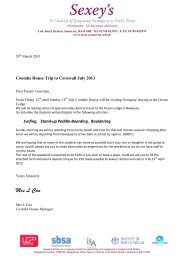Untitled - Sexey's School Moodle
Untitled - Sexey's School Moodle
Untitled - Sexey's School Moodle
You also want an ePaper? Increase the reach of your titles
YUMPU automatically turns print PDFs into web optimized ePapers that Google loves.
(sometimes, of the state itself),” argues Julius, “and is responsive to the contingencies of<br />
political life” (113). Observing that these works of art are confrontational, reflexive,<br />
disinterested, and public, and that they are consciously or purposely offensive, he notes<br />
that they are typically directed towards two types of audiences: the opposition, those they<br />
intend to offend, and those they intend to bring to an uprising.<br />
In an 1857 essay entitled “New Tendencies in Art,” Théophile Thoré observed<br />
that the modern era, which he welcomed, opened up traditional barriers between cultures<br />
and societies, and created a new “universal” society (379). He perceived that this<br />
breaking of boundaries had also occurred in art with the rise of Modernism, where fresh<br />
ideas, new perspectives, and radical concepts redefined previous conceptualizations of art<br />
by charting unexplored territory with regard to form and content, and expanding the<br />
horizons of what was possible. The relationship between art and institutional power are<br />
complex and ambiguous, for there are a number of alternatives of how the former can<br />
affect the latter: art can either precipitate, reflect or serve as an aid to understanding<br />
social and/or political changes. Contrary to the opinions of the critics above, Julius<br />
believes that over the last century, the category of transgressive works that aim to<br />
challenge the state has been ineffectual and stigmatized by failure. “The political<br />
challenges [of Art] … have been muted,” argues Julius (186) and in contrast to the use<br />
value of taboo-breaking art, he readily discards the subversive potential of the<br />
transgressive with regard to political discourses. He partly bases this conclusion on<br />
Theodor Adorno whom he quotes: “every work of Art is an uncommitted crime” (222).<br />
Art is a “crime” for its motive may be ideologically driven and aim to challenge existing<br />
political conditions, yet it remains “uncommitted” because by definition, Art is<br />
85



